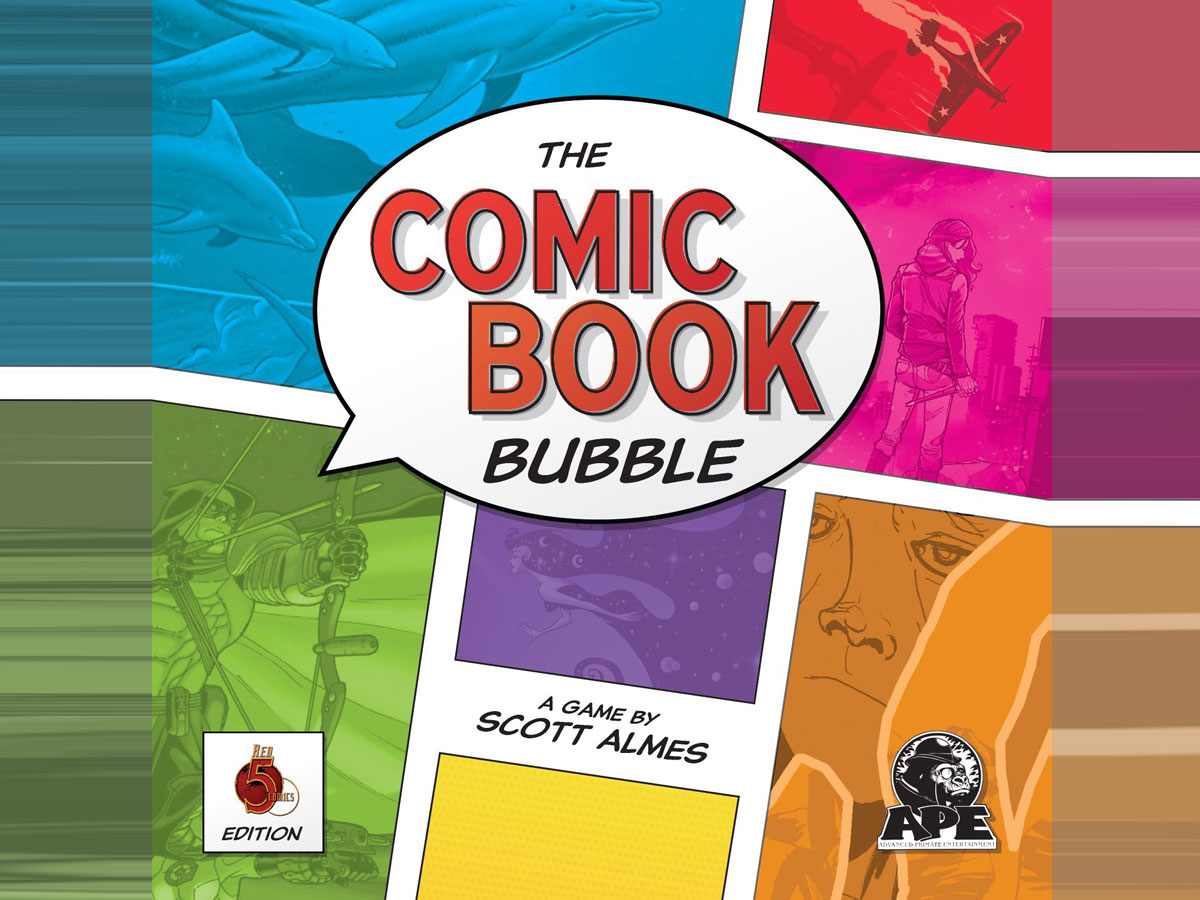It’s the early 1990s and comics are a hot commodity, if you can spot the winners. Can you turn a profit before the bubble bursts?
What Is The Comic Book Bubble?
The Comic Book Bubble is a market-manipulation game for 1 to 5 players, ages 10 and up, and takes about 45 minutes to play. It’s currently seeking funding on Kickstarter, with a pledge level of $20 for a copy of the game.
The Comic Book Bubble was designed by Scott Almes and published by APE Games, and includes artwork from Red 5 Comics.
New to Kickstarter? Check out our crowdfunding primer.

The Comic Book Bubble Components
Note: My review is based on a prototype copy, so it is subject to change and may not reflect final component quality. The prototype was for up to 4 players, so it doesn’t show the 5th player board. The small genre tokens may have the genre icons on them in the finished version, which would be a big help, especially for color blind players.
- Genre board
- 6 Genre tokens
- 6 Small Genre tokens
- 4 Player boards
- 15 Starting Comic cards
- 90 Comic Book cards
- Money tokens (in $1, $5, $10, $50 denominations)
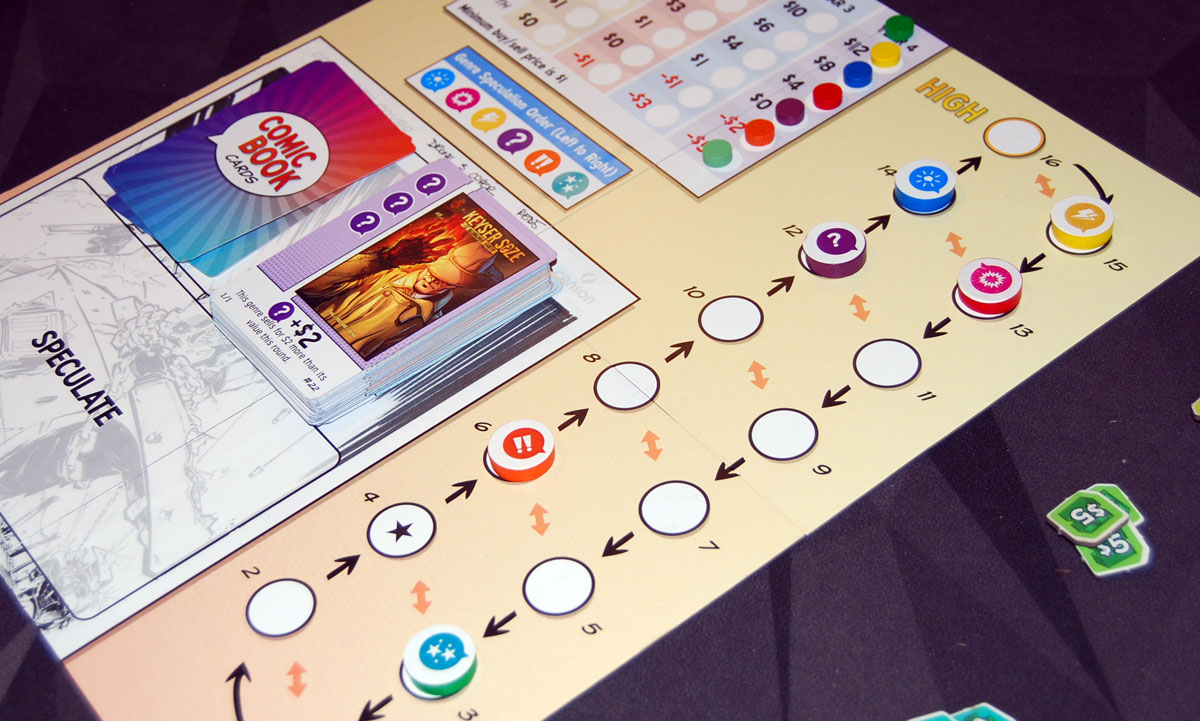
The genre board has room for a deck and discard, an area to play cards for the “speculate” action, and a market track that shows the relative values of the six different comic book genres in the game. The market track is interesting because you zigzag back and forth between the two columns to determine what’s high and what’s low, but the genres typically will move around the track in a loop, so that makes for some extra volatility in the prices.
The player boards are fairly simple, and are primarily a reminder of your available actions and your three catalog slots.

The comic book cards are fun: in addition to some genre icons and “superpowers” (card effects), each one also has an actual comic book cover from Red 5 Comics, which partnered with APE Games for this game. There’s a mix of different genres: sci-fi, horror, crime, fantasy … though the one that seems a little less represented is traditional superheroes. (Note to parents: the game is rated for 10 and up, but you may want to skim through the comics covers if you’re playing with younger kids, as it does include a few titles with zombies, guns, or scantily clad women.) It’s a fun way to make the theme a little more immersive, though at the same time it’s obvious that these aren’t comics from the 1980s and 1990s.
How to Play The Comic Book Bubble
You can download a draft of the rulebook here. It is also available to try for free on Tabletopia. My review will focus on the 2-4 player rules; the solo rules were not available yet when I was trying out the prototype.
The Goal
The goal of the game is to earn the most money over the course of four “years.”

Setup
Set up the genre board by mixing up the genre tokens and placing them on the market track, starting with the star and going clockwise. Arrange the small genre tokens in the same order on the price chart, under “Year 1.”
Shuffle the comic book cards and place it on the board in the designated spot.
Give each player a player board, 3 starting comic cards, and $20. Each player chooses two cards to keep and discards the third to the box; the two cards are placed in the player’s active catalog slots, above the player board.
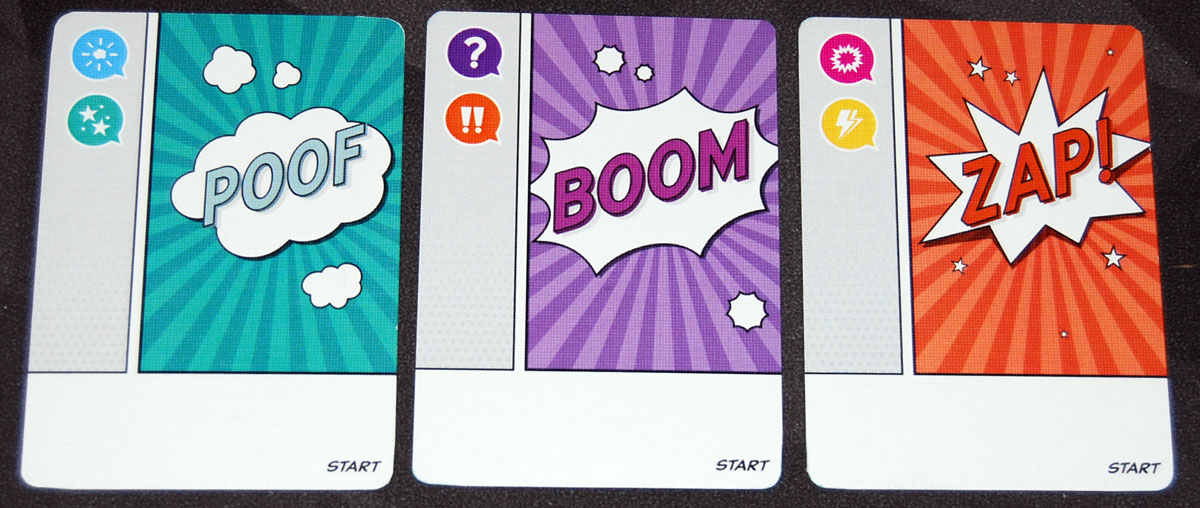
Gameplay
At the beginning of each year, everyone draws cards from the deck until they have a total of 5 cards.
Then, each round, you will follow these steps:
- Each player secretly selects 1 Card
- Players play their card into an Action Space
- Resolve Actions
- Sell Comics
- Pass Remaining Cards
The year lasts 4 rounds, and then you start a new year.

As genre tokens are moved around on the market track, the small genre tokens should be rearranged on the price chart to reflect the current market state. In the first year, the most valuable genre is worth $6 per icon, and the least valuable is worth $0. However, as the years progress, the prices get more extreme, from a high of $12 to a low of -$5, so it’s possible to lose money selling a comic.
There are three actions you may choose from: Buy, Superpower, and Speculate. Everyone simultaneously chooses a card from their hand, and plays it face-up to one of the three action spaces. (You aren’t supposed to see what action other players have chosen before you play your own card.) The actions are then resolved in the same order: Buy, Superpower, and Speculate.
Anyone who placed their card in “Buy” must now buy that card—the cost is based on the genre icons printed on the card, multiplied by the price of each genre according to the current market rate, with a minimum of $1 for the card. Pay the amount to the bank, and place the card above your player board in a catalog slot. You may only have up to 3 cards in your active catalog at a time.

Next any players who played a card as “Superpower” will resolve the ability printed at the bottom of the card. (If more than one player played a superpower card, they are resolved in “issue” order printed at the bottom right corner.) Superpowers may move genre tokens clockwise or counterclockwise around the market track (skipping occupied spaces), lock a genre token in place for the round, make a particular genre worth more money this round, or move a token across the arrow on the market track. The superpower cards are then discarded.
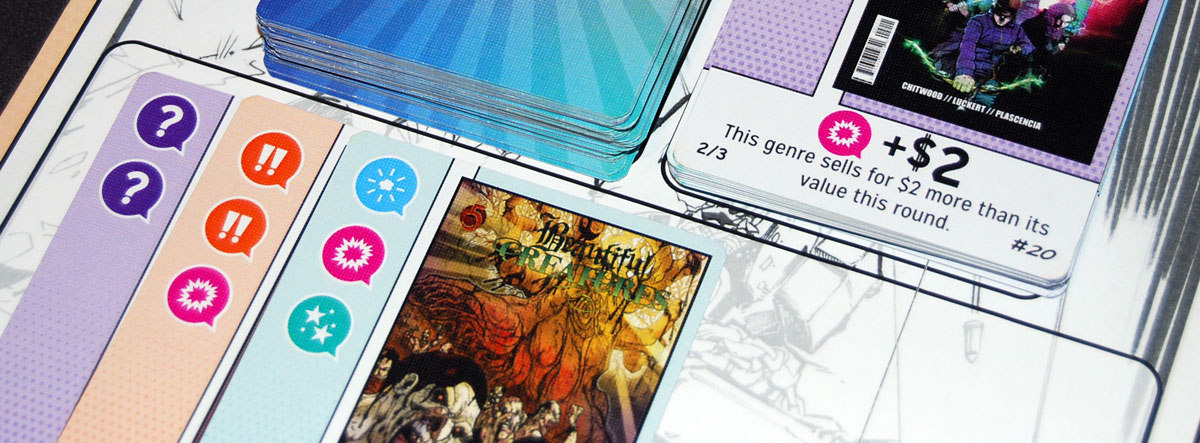
Then, all cards played in “Speculate” are now moved to the Speculate area of the genre board; if there are fewer than 3 players who chose speculate, add a card from the top of the deck. Following the genre order shown on the board, move each token clockwise a number of spaces equal to the number of matching genre icons on the cards. The cards are then discarded. (Remember to update the price chart to reflect the current market.)
Finally, all players who did not buy a comic this round may sell one comic from their active catalog slots at its current market prices, comparing the genre icons on the card to the price chart. The minimum price you sell a comic for is $1. When you sell a comic, the card goes face-down into the “back catalog” section of your player board.
Everyone passes their hand of cards to the left, and another round starts.
At the end of four rounds, everyone will have a single card left in hand. At this point, the year ends and the small genre tokens are moved to the next year, preserving the same order but resulting in new prices.
Game End
At the end of Year 4, all players must sell all remaining comics in their active catalog at the current market prices.
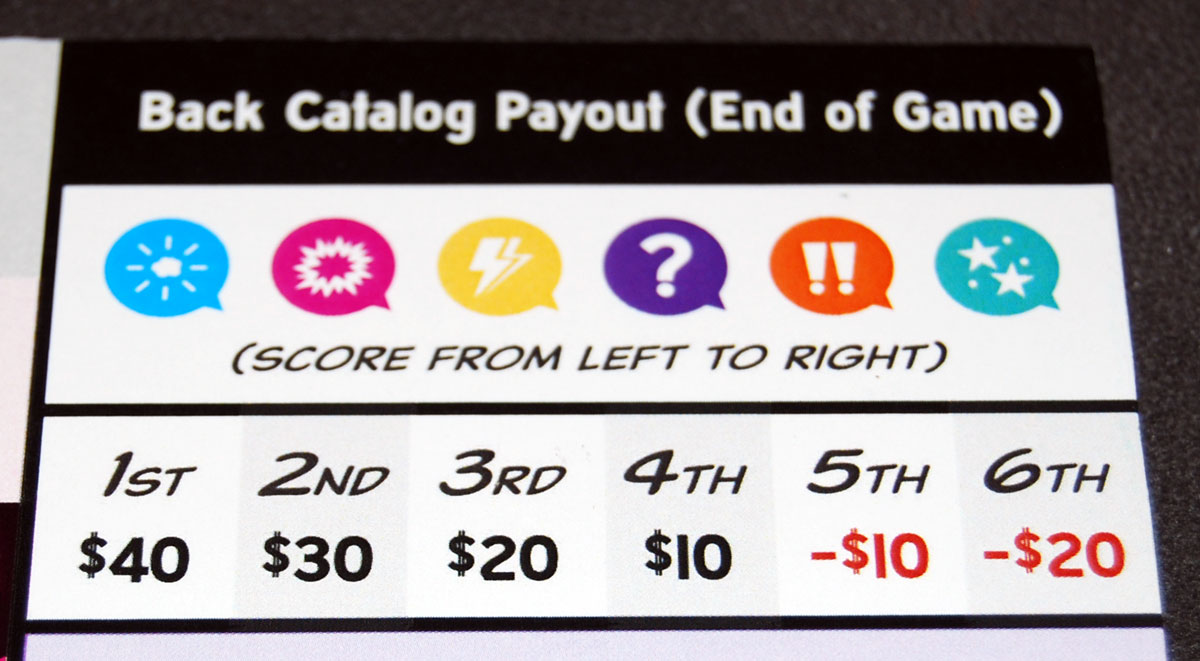
Everyone then reveals all the cards in their back catalog, totaling the number of symbols they have for each genre. The player with the most icons in a genre will gain or lose money based on that genre’s rank in the market. For instance, if you have the most icons of the most valuable genre, you earn $40, but if you have the most icons of the least valuable genre, you lose $20. (If there are ties, all tied players get the bonus or penalty.)
The player with the most money wins!

Why You Should Play The Comic Book Bubble
Everyone knows, of course, that the secret to making a fortune is to buy low, sell high—and that’s generally true of making money in The Comic Book Bubble as well. However, in this game you also have some say in the market values of the various genres, so you’ll be trying to manipulate the economy so that your chosen genres rise to the top just in time for you to sell them.
The rules themselves are actually pretty simple: pick a card and either buy it, use it for its superpower, or throw it into speculation to move some genre tokens around on the market. Sell comics when you feel you’ve got a good price. In practice, though, the fact that several players are all trying to tweak the market means that there can be a lot of chaos, not to mention there’s quite often a random card thrown into speculation as well.
The market track is the key to these fluctuations: the track is a loop and most of the time the various genre tokens will travel clockwise around the track. So if the token is on the left side, it’s on its way up, and if it’s on the right side, it’s on its way down. But several things make trends harder to predict: first, each spot can only have one token, so sometimes you’ll try to move a genre up, and it will skip too many spaces because they’re occupied and start heading back down the right side again. The other wrinkle is that although the tokens travel in a loop, you read them from top to bottom in a zigzag between the two columns. Depending on where other tokens are located, moving a token up only two spaces on the track could actually improve its position on the price chart by as many as 3 spaces!
All of that adds up to a volatile market, and success requires the ability to guess what other players are trying to do, but also a good amount of luck. Now, I suppose if you have a really good memory, you can try to remember what cards you passed the next player, but for my group it took most of our attention just to decide what we wanted to do ourselves, let alone trying to outguess our opponents. There were often laughs or groans when too many people tried to influence a particular genre and it ended up in a worse position than where it started.
Even though the prices get higher in later years, you really don’t want to wait too long to sell comics, because you can only have 3 cards in your active catalog. It doesn’t feel like a lot of profit when the maximum price per icon in Year 1 is only $6, but you don’t make money by just sitting on your investments forever.
The end-game scoring is also important. You’re allowed to look at your back catalog at any time, but it’ll be harder to remember what everyone else has. Do you have the most purple question marks in your catalog? Then you’ll want to try to get that to the top of the market by the time the game ends. But if you miscounted and one of your rivals has more purple question marks, then you just helped them earn a bonus!
Overall, I found The Comic Book Bubble to be a pretty wacky economics game. It was fun manipulating the market, trying to tank the value of comics that I could see in somebody else’s active catalog and waiting for the best time to cash out my own collection. It did feel a bit random at times, and I know that was frustrating for some players who wished they had a bit more control, but I liked the added uncertainty. If you like the idea of trying to make a fortune in a turbulent market, it’s worth taking a look!
For more information or to make a pledge, visit the The Comic Book Bubble Kickstarter page!
Click here to see all our tabletop game reviews.
![]() To subscribe to GeekDad’s tabletop gaming coverage, please copy this link and add it to your RSS reader.
To subscribe to GeekDad’s tabletop gaming coverage, please copy this link and add it to your RSS reader.
Disclosure: GeekDad received a prototype of this game for review purposes.
